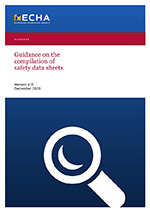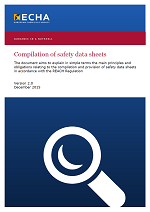Information on safety data sheets for the German market
The safety data sheet
The safety data sheet is a key element in the communication in the supply chain. It delivers important information on dangerous substances and mixtures for the professional user. Among others these are information on the identity of the product, on the assigned hazard classes and categories, on safe use and on measurements in case of an accident.
The rules for compiling a safety data sheet are laid down in Article 31 and Annex II of the REACH regulation. Annex II was already amended several times since it entered into force. The current version of Annex II can be found in Regulation (EU) 2015/830. But due to changes in the UN GHS - which is the basis for safety data sheets - there will be other amendments in the future.
The supplier of a dangerous substance or mixture is responsible for correctly compiling the safety data sheet and for providing it in an appropriate way to his costumers. This can be done electronically or on paper.
Safety data sheets for substances usually have exposure scenarios annexed. This is called the extended safety data sheet. Exposure scenarios are part of the chemical safety report which has to be prepared in the registration process under REACH. They describe the conditions of the safe use for all uses identified in the registration dossier.
Guidance
Compiling a safety data can be a challenge for any company. Therefore the European Chemicals agency together with stakeholders from member states and industry developed a comprehensive guidance document. The „Guidance on the compilation of safety data sheets“ is available in all official EU languages.
Information on national aspects when compiling safety data sheets for the German market can be found in the TRGS220 „Safety data sheet“. The TRGS was prepared by the German Committee for Hazardous substances (AGS) and published in the Joint Ministerial Gazette.
Language
The safety data sheet has to be provided in an official language of the member state where the substance or mixture is placed on the market. In Germany it has to be provided in German. The ECHA has published a list of all member states and the languages required in the safety data sheet and on the label of the product.
Providing electronically
The safety data sheet has to be provided on paper or electronically. Which way is chosen by a company may depend on the contractual arrangements with a certain costumer. The electronic distribution may be done on data storage media or via email. The publication on the company´s homepage solely is not enough. It does not fulfil the requirement of actively providing the document. The duty to provide may be fulfilled e. g. when the costumer receives a direct link to the respective SDS via email. Prerequisites for this are that the costumer has an internet and email account and has explicitly agreed to this way of delivery.
Emergency telephone number in Section 1.4
According to Section 1.4 of Annex II of the REACH regulation in section 1.4 of the safety datasheet (SDS) an emergency telephone number shall be provided. This may be for example an official advisory body of the member state, where the substance or mixture is placed on the market.
Until further notice the German poison information centres do not have the legal status of an official advisory body according to Annex II section 1.4 of the REACH-Regulation. Therefore in Germany suppliers in principle have to provide their own emergency telephone number. For the emergency telephone service certain conditions have to be met: inter alia qualified medical advice in emergency cases needs to be provided in German language.
It is not possible or sufficient to provide the telephone number of the Bundesinstitut für Risikobewertung (Federal Institute for Risk Assessment - BfR) or one of the general EU emergency numbers (112 / 116117) in the SDS.
However, the use of the emergency telephone number of one of seven of the German poison centres in Section 1.4 is offered as a paid service. Before making use of that service, suppliers have to contact and make an agreement with one of the poison information centres. An agreement may include for example forwarding information on dangerous components or possible costs.
In principle it is also possible to contract such a service from any other third party, given that the above mentioned criteria are fulfilled.


